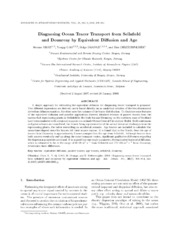Diagnosing ocean tracer transport from Sellafield and Dounreay by equivalent diffusion and age
Peer reviewed, Journal article
Permanent lenke
https://hdl.handle.net/1956/3212Utgivelsesdato
2008-09-27Metadata
Vis full innførselSamlinger
- Geophysical Institute [1198]
Originalversjon
https://doi.org/10.1007/s00376-008-0805-ySammendrag
A simple approach for estimating the equivalent diffusion for diagnosing tracer transport is proposed. Two different expressions are derived; one is based directly on an analytical solution of the two-dimensional advection-diffusion equation, the other uses the variance of the tracer distribution. To illustrate some features of the equivalent diffusion and possible applications thereof, idealized releases of passive tracers from the nuclear fuel reprocessing plants at Sellafield in the Irish Sea and Dounreay on the northern coast of Scotland have been simulated with a regional isopycnic co-ordinate Ocean General Circulation Model. Both continuous and pulse releases are considered; the former being representative of the actual historical discharges from the reprocessing plants, the latter resembling an accidental scenario. Age tracers are included to calculate the mean time elapsed since the tracers left their source regions. It is found that in the Nordic Seas the age of tracers from Dounreay is approximately 2 years younger than the age from Sellafield. Although tracers from both sources eventually end up along the same transport routes, significant qualitative differences regarding the dispersion properties are found. It is argued that one single parameter, the equivalent horizontal diffusion, which is estimated to be in the range of 20–56 m2 s−1 from Sellafield and 170–485 m2 s−1 from Dounreay, determines these differences.
